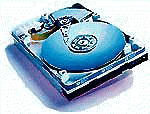How Do They Work?
Computers are
getting so fast nowadays that it isn’t just a matter of processor speed.
The new CPUs are running faster than I need for day-to-day business. The
real bottleneck is the hard drive. Look at how a hard drive is built.
The read/write head reads the data. It travels across the platters—top
and bottom sides—looking for your files. It looks like an old-fashioned
record player doesn’t it? But, unlike a record, the data isn’t stored
like a sound track.
When a hard drive is formatted, the surfaces of the disks are organized
into tracks and sectors. For most systems, including PCs and
Macintoshes, sectors typically contain 512 bytes of user data plus
addressing information. The disk drive controller uses this information
like a map to read and write information to the disks. Without a map, it
would be impossible to find anything on the disk.
When you ask for a file, the operating system seeks that file by a
physical location on the hard drive: head number, cylinder, and sector
number. The actuator arm moves over the sectors until it locates the
name address. Everything on that sector, including the data you want is
stored into a cache. That data is then sent to the RAM.




